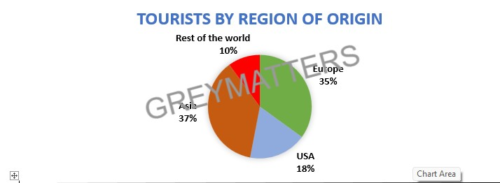Nigeria Latest Speaking Questions – July 2024
August 29, 2024Australia – Latest IELTS Writing Task 1 & 2 – July 2024 (Academic)
August 30, 2024WRITING TASK 1
The pie chart below shows the percentage of tourists visiting a holiday destination, categorised by their region of origin. The table provides additional details about these tourists, including their average length of stay, most popular accommodation, and main activity.
Summarize the information by selecting and reporting the main features, and make comparisons where relevant.


Write at least 150 words (You should spend 20 minutes on this task).
Sample Answer
The chart and table provide an overview of tourists visiting a holiday destination in Australia, categorized by region of origin. The chart shows that the majority of tourists come from Asia (37%) and Europe (35%), followed by the USA (18%) and the rest of the world (10%).
The table details the tourists’ average length of stay, preferred accommodation, and main activities. European tourists tend to stay the longest, with an average of 16 days, preferring campgrounds and caravan parks, while their main activity is swimming and sunbathing. American tourists, who stay for 14 days on average, favor 4-star hotels and primarily engage in sightseeing, similar to Asian tourists, who stay for 7 days and prefer 5-star hotels. Tourists from the rest of the world stay for 10 days, prefer campgrounds/caravan parks, and are mostly interested in surfing.
Overall, there is a clear regional distinction in preferences, with varying lengths of stay and activities based on origin.
WRITING TASK 2
Nowadays many students go traveling or working for a year after graduating from high school and before starting university.
Are there more advantage disadvantage to this trend?
Sample Answer
Taking a gap year between high school and university has become an increasingly popular trend among students. This period is often spent traveling, working, or volunteering, and while it offers several advantages, it also comes with certain disadvantages.
One of the primary advantages is the opportunity for personal growth. Traveling or working during a gap year allows students to gain real-world experience, develop independence, and improve their cultural awareness. This time can also help students clarify their academic and career goals, leading to more informed decisions when they eventually start university. Additionally, students who work during their gap year can save money to fund their education, reducing the financial burden of university expenses.
However, there are also disadvantages to consider. A gap year can disrupt the momentum of academic study. Students may find it challenging to return to the structured environment of university after a year of relative freedom. There’s also the risk of losing focus or motivation, which could potentially delay their academic and professional progress. Financially, while some students may save money, others might find themselves spending more on travel or other activities during their gap year, which could strain their resources.
In conclusion, while taking a gap year offers valuable opportunities for personal and professional development, it also carries risks that students should carefully consider. The decision to take a gap year should be based on individual circumstances, including personal goals, financial situation, and the ability to maintain academic focus.
















